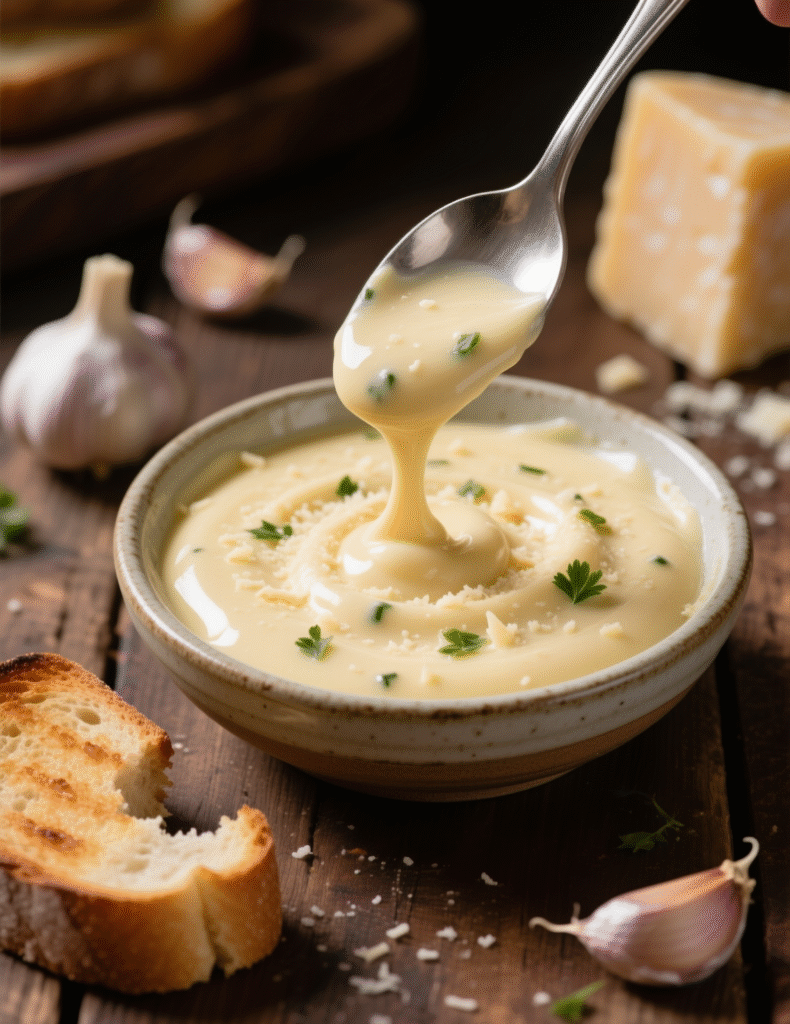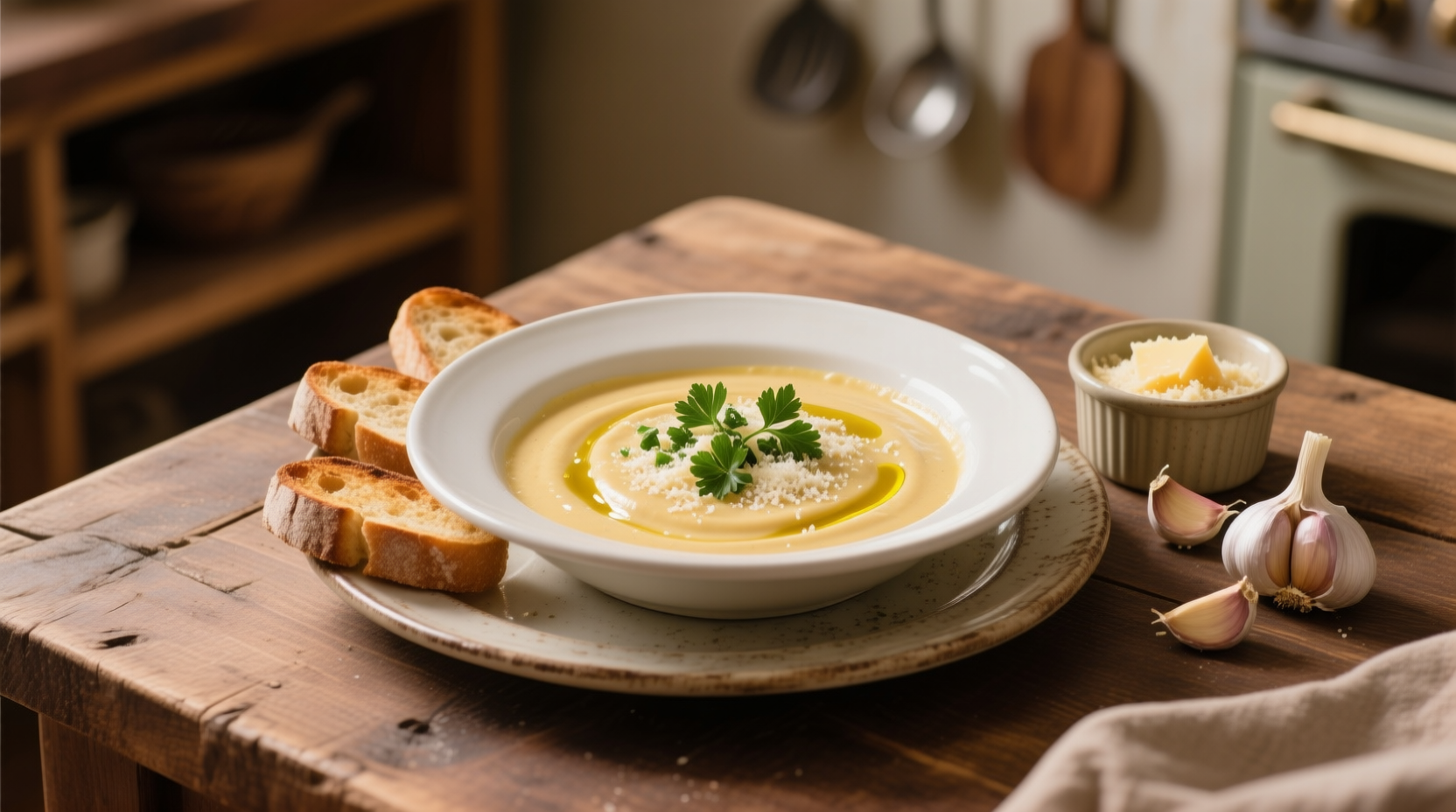Garlic parmesan sauce isn’t just another creamy condiment. It’s one of those sauces that quietly takes over a dish and makes you wonder how you ever cooked without it. Restaurants guard their versions, but the truth is, if you understand the science of emulsions and the balance of flavor, you can make a garlic parmesan sauce at home that rivals anything you’d find in a professional kitchen. This article is more than a recipe—it’s a deep dive into the technique, the variations, and the subtle tricks that give this sauce its legendary richness.
Why Garlic Parmesan Sauce Deserves Respect
Some people think of it only as a wing sauce. That’s a mistake. Its versatility is staggering. Toss it with pasta, spoon it over roasted vegetables, or use it as a dip for crusty bread—it’s always a winner.
The pairing of garlic and parmesan has a long culinary history. Garlic provides pungency and warmth, while parmesan lends saltiness, nuttiness, and umami. Together, they create what food scientists call “synergistic flavor”—a taste stronger than the sum of its parts. The high glutamate content in parmesan interacts with the sulfur compounds of garlic to build depth that lingers on the tongue.
The Building Blocks of the Sauce
Garlic parmesan sauce at its core is an emulsion. You’re bringing fat and water together into a smooth mixture that clings to food.
The main ingredients:
- Butter or olive oil as the fat base. Butter brings creaminess and sweetness. Olive oil gives a sharper, Mediterranean edge.
- Garlic—fresh, roasted, or even confit, each method of preparation changes the flavor profile.
- Heavy cream or half-and-half to create body. Cream stabilizes the emulsion and softens the garlic’s bite.
- Parmesan cheese—ideally aged Parmigiano-Reggiano, freshly grated. The pre-grated powder in a green can will not do justice here.
- Salt, black pepper, and sometimes nutmeg—tiny touches that refine the flavor without drawing attention to themselves.
The sauce may also include mayonnaise or cream cheese in certain restaurant adaptations, especially for dipping sauces. But purists stick to butter, cream, and parmesan.
Garlic: The Heart of the Sauce
Garlic is never just garlic. Raw garlic is sharp, almost spicy. Sautéed garlic turns mellow, nutty, and aromatic. Roasted garlic goes even further—sweet, caramelized, spreadable like butter.
Professional chefs often combine two methods. For example, start with sautéed garlic for aroma, then fold in roasted garlic at the end for depth. The ratio of garlic to fat matters: too much and the sauce turns bitter; too little and it fades behind the parmesan.
Research published in the Journal of Food Science notes that sulfur compounds in garlic break down differently depending on cooking method. Slow roasting preserves sweetness, while quick high-heat sautéing intensifies sharpness. Knowing this lets you design the sauce for the dish you’re pairing it with.

Parmesan: Why Quality Cannot Be Faked
There is parmesan, and then there is Parmigiano-Reggiano. The latter is a protected product in Italy, aged at least 12 months, sometimes up to 36. The crystalline texture and sharp umami are what make the sauce extraordinary.
Cheap parmesan substitutes usually contain cellulose to prevent clumping. That filler prevents proper melting and ruins the texture of the sauce. Freshly grated parmesan melts smoothly into hot cream and thickens it naturally. It’s not just about taste—it’s about structure.
A trick many chefs use: add parmesan gradually, off the heat. Too much heat will cause the cheese to seize and turn grainy. A gentle fold-in creates silkiness.
Technique: Making Garlic Parmesan Sauce Like a Pro
Here’s a professional step-by-step method:
- Start with fat. Melt butter or warm olive oil in a pan over low-medium heat.
- Cook the garlic. Add minced or smashed garlic. Let it bloom slowly—don’t rush it. Burnt garlic is unrecoverable.
- Add cream. Pour in heavy cream and let it simmer gently. This stabilizes the emulsion.
- Season lightly. Add a pinch of salt, cracked black pepper, and if you dare, a micro-grating of nutmeg.
- Thicken with parmesan. Remove the pan from heat and whisk in parmesan gradually until it melts smooth.
- Adjust texture. If too thick, loosen with a spoon of milk. If too thin, simmer gently for a few more minutes.
At this stage, taste matters more than measurements. Some chefs prefer a sauce that drips thinly, perfect for wings. Others build it thick and clingy, made for pasta or grilled chicken.
Common Mistakes and How to Avoid Them
- Overheating the cheese: leads to gritty texture. Always add parmesan off the heat.
- Burning the garlic: once it turns bitter, there’s no saving the sauce. Low and slow is safer.
- Using poor cream substitutes: milk or plant-based substitutes can work, but the fat content must be high enough to prevent curdling. A 30–36% fat cream is ideal.
- Forgetting acid: a few drops of lemon juice at the end can brighten the sauce. Many chefs skip it, but that little acidity sharpens the richness.
Variations Worth Exploring
Garlic parmesan sauce isn’t locked to one tradition. It adapts beautifully.
- Spicy version: Add crushed red pepper flakes for heat. Perfect for wings.
- Herbed version: Fold in fresh parsley, basil, or thyme at the end for freshness.
- Smoky version: Use roasted garlic and smoked paprika. Works wonders on grilled vegetables.
- Lighter Mediterranean style: Replace cream with Greek yogurt and olive oil. It won’t be as rich, but it’s tangy and fresh.
Case in point: one chain restaurant in the U.S. mixes mayo with parmesan and garlic powder for speed. But independent Italian trattorias still simmer butter, garlic, and cream slowly, giving diners a sauce that feels alive instead of flat.
Garlic Parmesan in Modern Food Culture
The sauce exploded in popularity in the early 2000s when chains like Buffalo Wild Wings introduced garlic parmesan wings. Suddenly, it wasn’t just an Italian pasta sauce—it was pub food, finger food, comfort food.
Market data from Technomic shows that “garlic parmesan” as a menu descriptor has grown steadily in the U.S. over the past decade, appearing not only in wing sauces but also in burgers, fries, and even pizza crust dips. The flavor combination has broad appeal: garlic signals boldness, parmesan signals indulgence.
Professional chefs now face the challenge of reinterpreting garlic parmesan sauce in fresh ways. Some blend it into compound butters. Others whip it into aioli for sandwiches. The trend isn’t slowing down—it’s adapting.
Pairing Garlic Parmesan Sauce with Dishes
Where does this sauce shine? Pretty much everywhere.
- Pasta: Toss with fettuccine for a simplified Alfredo.
- Wings: Coat crispy chicken wings, then finish with extra grated parmesan on top.
- Vegetables: Roasted broccoli or cauliflower love being drenched in it.
- Seafood: Shrimp sautéed in garlic parmesan sauce feels decadent but fast.
- Bread: A dip for warm focaccia or breadsticks—crowd-pleasing every time.
Even mashed potatoes transform with a swirl of garlic parmesan sauce. Try it once, and plain potatoes will feel unfinished forever.

Nutrition and Health Considerations
There’s no denying it: garlic parmesan sauce is indulgent. A typical serving (about 2 tablespoons) can carry 120–150 calories, mostly from fat.
But fat isn’t the villain it once was. Research in The American Journal of Clinical Nutrition shows that dietary fat in moderation supports satiety and nutrient absorption. Parmesan also brings protein and calcium, while garlic provides antioxidants and compounds linked to cardiovascular benefits.
For lighter versions, swap cream with evaporated milk or cashew cream. Some chefs experiment with cauliflower puree to mimic creaminess with fewer calories.
Professional Insights: What Sets Great Sauce Apart
In professional kitchens, consistency is king. The same sauce must taste perfect at 2 p.m. and 10 p.m. That means controlling heat, using quality parmesan, and keeping ratios balanced.
One executive chef in New York once told me: “The sauce is like a symphony. Garlic’s the soloist, but parmesan is the orchestra. If one drowns the other, the music is lost.” That balance is what separates a homemade quick fix from a restaurant-quality sauce.
Texture is another overlooked detail. Some chefs prefer silky smooth; others embrace a slightly rustic, cheesy grain. Both can be right, depending on the dish.
Conclusion: Bringing It All Together
Garlic parmesan sauce isn’t difficult, but it’s easy to get wrong if you rush. The secret lies in respect—respect for the garlic, for the parmesan, for the slow dance of fat and cream.
Remember the key lessons: roast or sauté garlic with care, use real Parmigiano-Reggiano, and add cheese off heat. Season gently, and don’t be afraid to finish with a splash of lemon for brightness.
What makes this sauce irresistible isn’t just flavor—it’s its ability to transform any dish it touches. From wings to pasta to roasted vegetables, it takes ordinary ingredients and makes them feel like something special. And isn’t that what great cooking is all about?
FAQs
What is garlic parmesan sauce made of?
It’s usually made from butter, cream, garlic, and parmesan cheese, with light seasoning.
Can I use pre-grated parmesan?
Freshly grated parmesan melts smoother—pre-grated often turns grainy.
How do I stop garlic from burning?
Cook it on low heat and stir often; burnt garlic ruins the sauce.
Can I make garlic parmesan sauce without cream?
Yes, try cashew cream, evaporated milk, or Greek yogurt for lighter versions.
Why is my sauce grainy?
Overheating parmesan or using poor-quality cheese usually causes this.
How do I thicken garlic parmesan sauce?
Simmer gently to reduce or add more parmesan for natural thickness.
Can this sauce be frozen?
It’s best fresh; freezing often breaks the creamy texture.
Is garlic parmesan sauce healthy?
It’s indulgent but offers protein, calcium, and antioxidants when eaten moderately.
What dishes pair best with this sauce?
Pasta, wings, roasted vegetables, seafood, and even bread dips.
How do restaurants make it taste so good?
They use quality ingredients, balanced ratios, and finish with small details like lemon.

Mariana is a passionate home cook who creates delicious, easy-to-follow recipes for busy people. From energizing breakfasts to satisfying dinners and indulgent desserts, her dishes are designed to fuel both your body and hustle.
When she’s not in the kitchen, she’s exploring new flavors and dreaming up her next recipe to share with the Foodie Hustle community.

